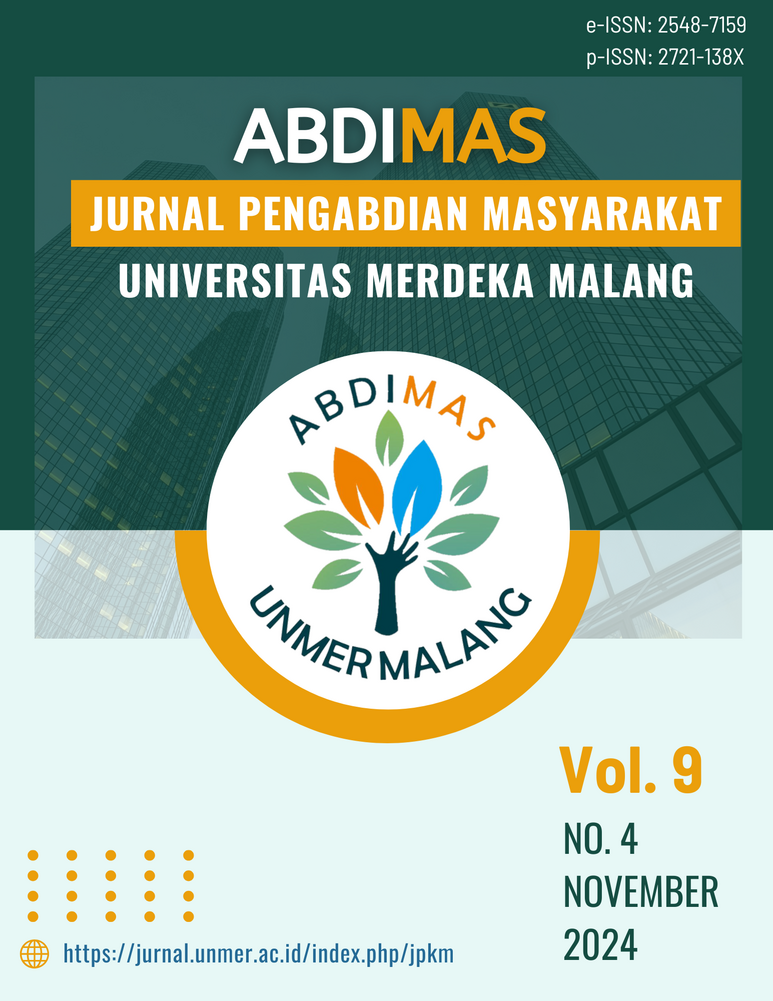Training development of meat-based BASECHI to improve the quality of public health in meatball vendors
DOI:
https://doi.org/10.26905/abdimas.v9i4.13969Keywords:
Chitosan, Edible coating, Meatballs, Meatball’s vendorsAbstract
The large number of meatball producers who still use dangerous preservatives needs to be stopped. The use of alternative natural preservatives that do not cause side effects on consumers such as chitosan needs to be introduced so that it can be used by many people. BASECHI (Chitosan Healthy Meatballs) development training includes a series of socialization activities designed to empower meatball traders with the knowledge and skills in making meatballs containing chitosan, a natural compound that has important health benefits. The activity begins with participants undergoing a pre-test to measure initial knowledge. Providing material by experts on the benefits of chitosan and techniques for making healthy meatballs. Practicing chitosan application to meatballs and continuing with a post-test session to assess participants' knowledge. The program ends with closing activities that include discussion, feedback, and further planning to ensure the continuity and sustainability of the knowledge gained. The expected results of this training are increased awareness of traders about the importance of food quality, mastering skills in making healthy meatballs, and improving the quality of public health through the consumption of more nutritious products.
Downloads
References
Aulia, A. P., Saefullah, A., Rifia, T. N. I., Saksana, J. C., Upe, R., Tahang, M., Saputri, H., Misbah, I., Umam, M. K., Aini, S., & Noor, A. S. (2021). Sosialisasi peningkatan kinerja kasir pada PT Kitita Alami Propertindo. KREATIF: Jurnal Pengabdian Masyarakat Nusantara, 1(4), 86-102. https://doi.org/10.55606/kreatif.v1i4.3922
Baharuddin, B., Sitopu, J. W., Safarudin, M. S., Adam, M. W. S., & Safar, M. (2024). Mengenal Internet of Things (IoT): Penerapan konsep dan manfaatnya dalam kehidupan sehari-hari. Journal of Human and Education (JAHE), 4(4), 827-835. https://doi.org/10.31004/jh.v4i4.1348
Boeriu, C. G., & van den Broek, L. A. (2019). Chemical and enzymatic modification of chitosan to produce new functional materials with improved properties. Chitin and Chitosan: Properties and Applications, 245-258. https://doi.org/10.1002/9781119450467.ch10
Ditta, A. S. A., & Candrani, A. D. (2023). Pelatihan pembukuan sederhana dan implementasi point of sales pada UMKM Kota Madiun. Society: Jurnal Pengabdian dan Pemberdayaan Masyarakat, 4(1), 36-46. https://doi.org/10.37802/society.v4i1.366
Gita, R. S. D., & Waluyo, J., Dafik, D., & Indrawati, I. (2022). The effectiveness of using chitosan as a natural antibacterial for maintaining the sausage quality. Food Research, 6(4), 146-153. http://dx.doi.org/10.26656/fr.2017.6(4).007
Harjanti, R. S. (2014). Kitosan dari limbah udang sebagai bahan pengawet ayam goreng. Jurnal Rekayasa Proses, 8(1), 12-19. https://doi.org/10.22146/jrekpros.5018
Mustafiah, M., Darnengsih, D., Sabara, Z., & Majid, R. A. (2018). Pemanfaatan kitosan dari limbah kulit udang sebagai koagulan penjernihan air. Journal of Chemical Process Engineering, 3(1), 27-32. https://doi.org/10.33536/jcpe.v3i1.191
Nababan, A. A., Jannah, M., & Sianturi, F. A. (2022). Pelatihan Sistem Informasi Penelitian dan Pengabdian kepada Masyarakat (SIM-PPM) STMIK Pelita Nusantara. Jurnal Pengabdian Kepada Masyarakat Nusantara, 3(1), 241-251. https://doi.org/10.55338/jpkmn.v3i1.325
Nirmala, D., Masithah, E. D., & Purwanto, D. A. (2016). Kitosan sebagai alternatif bahan pengawet kamboko ikan kurisi (Nemipterus nematophorus) pada penyimpanan suhu dingin. Jurnal Ilmiah Perikanan dan Kelautan, 8(2), 109-125.
Safirin, M. T., Samanhudi, D., & Aryanny, E. (2023). Pemanfaatan teknologi packaging untuk meningkatkan kualitas dan keamanan produk pangan lokal. Jurnal Abdimas Peradaban, 4(1), 31-41. https://doi.org/10.54783/ap.v4i1.21
Sari, S. R., Kanya, M. R., Rizki, R. R., Guttifera, G., & Riswandi, A. (2023). Modifikasi kitosan asap cair cocos nucifera sebagai pengawet alami pangan (Antibakteri Staphylococcus aureus). Jurnal Perikanan Unram, 13(4), 951-957. https://doi.org/10.29303/jp.v13i4.645
Sedjati, S., Agustini, T. W., & Surti, T. (2007). Studi penggunaan khitosan sebagai anti bakteri pada ikan teri (Stolephorus heterolobus) asin kering selama penyimpanan suhu kamar the effect of chitosan concentration on quality of dried-salted anchovy (Stolephorus heterolobus) during room temperature storage. Jurnal Pasir Laut, 2(2), 54-60.
Sulaeman, A., Bramasta, D., & Makhrus, M. (2023). Pemberdayaan masyarakat dengan pendekatan Participatory Rural Appraisal (PRA). Jurnal Literasi Pengabdian dan Pemberdayaan Masyarakat, 2(2), 87-96. https://doi.org/10.61813/jlppm.v2i2.34
Wahditiya, A. A., Kurniawan, A., Nendissa, J. I., Meyuliana, A., Yora, M., Jamilah, J., Ilham, D. J., Mufaidah, I., Alaydrus, A. Z. A., & Hidayati, F. (2024). Teknologi produksi tanaman pangan. Yayasan Tri Edukasi Ilmiah.
Downloads
Published
How to Cite
Issue
Section
License
Copyright (c) 2024 Abdimas: Jurnal Pengabdian Masyarakat Universitas Merdeka Malang

This work is licensed under a Creative Commons Attribution-ShareAlike 4.0 International License.
Authors who publish with this journal agree to the following terms:
- Copyright of the published articles will be transferred to the journal as the publisher of the manuscripts. Therefore, the author confirms that the copyright has been managed by the journal.
- Publisher of Abdimas: Jurnal Pengabdian Masyarakat Universitas Merdeka Malang is University of Merdeka Malang.
- The copyright follows Creative Commons Attribution-ShareAlike License (CC BY SA): This license allows to share, copy, and redistribute the material in any medium or format, adapt, remix, transform, and build upon the material, for any purpose, even commercially.





